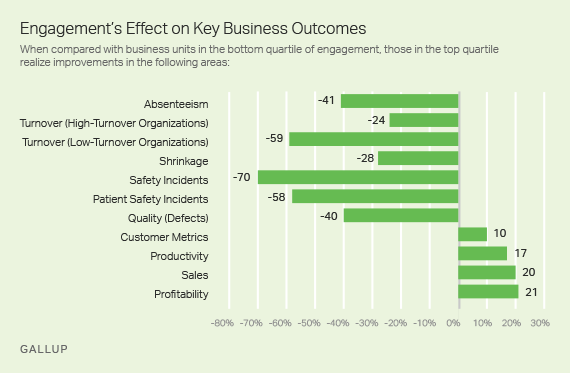Why Improving
Employee Engagement Should Be Your Priority ???
In
recent years, employee engagement has emerged as a popular organizational
concept.Large corporations, including
Microsoft, are starting to pour significant amounts of time and money into educating
people, through webcasts (registration
required) and other vehicles, on the importance of employee engagement.
The
concept is quickly evolving from a simple focus on job motivation to a complete
understanding of how a truly engaged employee has a direct impact on
productivity. For any company that’s looking to be more effective and
productive, increasing employee engagement should be a primary focus.
Employee engagement can be defined as the level of commitment and involvement
employees have toward an organization and its mission, values and beliefs.The
concept of employee engagement has naturally evolved from past research on high
involvement, empowerment, job motivation, organizational commitment and trust.
It’s about creating an environment that motivates employees to want to connect
with their work and really care about doing a good job for themselves and the
company.
Understanding Employee Engagement
An engaged employee is conscious of the
business context. Being engaged makes it easier for employees to work together
with colleagues to improve their job performance, for the larger benefit of the
organization as a whole. True employee engagement comes about when enough
people within a company not only care about doing a good job, but also care
about what the organization is trying to achieve and how it goes about doing
it.Key
factors that contribute to employee engagement include the following:
- ·
Giving
employees autonomy to act in support of organizational goals.
- ·
Aligning
employees toward strategy.
- ·
Creating
a continuing culture of engagement.
An organization will recognize it has
reached a high level of employee engagement when a significant percentage of
its employees care about the company and are concerned with achieving their own
organizational goals. This caring attitude and behavior only develops when
people are consistently satisfied with their jobs and when they believe the organization
supports them. Research from Gallup indicates the average level of
U.S. employment engagement hovers between 30 and 40 percent.
The Importance of Employee Engagement
All
companies should want their employees to be engaged. Many studies have proved
not only that employee engagement is linked to productivity, but also that it
can be directly tied to greater customer satisfaction, which, in turn, drives
an organization’s financial success.
Employee
understanding and knowledge of an organization’s capabilities and current
productivity levels have a major positive impact on engagement. When employees
have a clear understanding of these concepts, they are more engaged because
they can definitely see how their individual efforts directly impact the
organization’s success.
High
levels of employee engagement depend on several conditions in the workplace.
· Culture - A strong and
defined organizational culture helps connect and align a company’s processes to
its business decisions. Culture can play a big role in who is hired, and it can
be hard to drive engagement if you hire an employee who isn’t aligned with a
company’s culture.
· Policies - Policies that
are continually reinforced act as facilitators for employees to achieve their
personal goals, and ultimately the organization’s goals.
· Metrics - The most
engaged organizations are the ones that show and share performance metrics.
Data-driven organizations tend to have the most engagement because they give
employees a measurable metric they can use to gauge personal job performance.
· Performance - It is well
known that organizational performance drives personal job satisfaction and a
greater sense of belonging.
Driving a Culture of Engagement and
Productivity
A
recent analysis from Dale Carnegie and Gallup identifies the following steps as
key drivers of high levels of employee engagement:
1.
Have
a clear internal communication strategy.
2.
Execute
the communication strategy effectively.
3.
Promote
and enable better business transparency.
4.
Communicate
organizational strategies and plans.
5.
Encourage
open communication and recognition.
6.
Recognize
and reward employee’s efforts.
7.
Practice
social leadership.
The
most influential driver of employee engagement is open and transparent
communication from top to bottom. An organization that wants to achieve that
degree of communication must implement the right tools and technologies.
Technologies That Enable Communication
and Engagement
Many
of the key engagement drivers rely on the use of up-to-date technology.
Therefore, many organizations are moving toward embracing new communication and
collaboration technologies.
Chat and collaboration tools like Microsoft Teams Microsoft Teams, Yammer and Slack have become
popular in the past few years. Companies often specifically deploy them with
the goal of replacing email as the primary means of communication. Microsurvey applications, which offer
quick and efficient ways to take the pulse of your workforce by conducting
employee surveys, are another type of tech tool companies can use to improve
employee engagement. Options in this category include Tinypulse and Officevibe,
both of which allow you to measure engagement and track your organization’s
performance. Real-time recognition also plays a big role in employee engagement.
Social networking platforms are good venues for honoring employees’
achievements with badges and rewards.
The
tools, tactics and drivers discussed here can greatly increase your
organization’s ability to collaborate, communicate, be transparent, recognize
employee achievements and gather feedback.
If
your company is actively working toward building a culture of employee
engagement and is using emerging technologies to drive engagement, you will
surely see a positive impact on bottom-line metrics.
References




